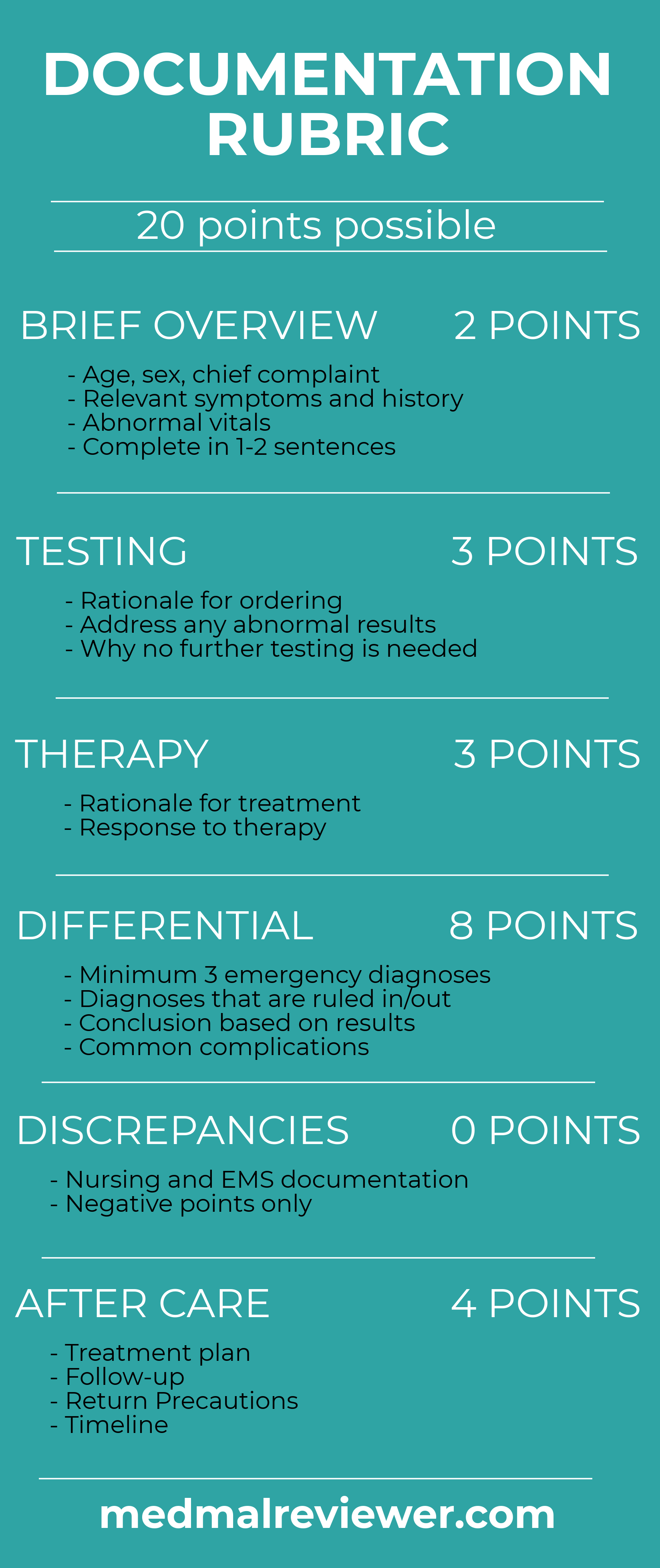Documentation Rubric
In order to provide a clear structure for reviewing the malpractice cases, I have created a Documentation Rubric to help guide the assessment of the documentation. Rather than just mindlessly recording how a reader feels about the documentation, this rubric will help us make a fair and objective analysis of the documentation. It will help highlight the positive aspects about a note, and bring some of the negatives to our attention.

You may notice that the Rubric is similar to the Template, but has some key differences. Many of the categories from the Template are combined together into individual parts of the Rubric. While the Template provides suggestions for how to structure your documentation, they are simply suggestions. No one is obligated to use the Template (although it is certainly recommended). The Rubric takes into account the many different documentation styles among doctors. The focus of the Rubric is less on the organizational scheme and more on the information that is included. The Rubric takes a big picture approach to analyzing and grading notes. It seeks to find the overarching rationale that should be included in the medical decision-making (MDM) section of your note. The overarching rationale of your MDM is assessed by the larger conceptual categories of the Rubric rather than minute, granular points or rigid organization requirements.
The scoring system listed above helps provide an overall assessment of the note. The use of a single number helps convert complicated ideas into one simple grade. There are admittedly ways in which this approach is imperfect, but it is the easiest way to provide a rapid judgment of the quality of a note. Each of the sections are given a number value based on the relative importance of the section. Some parts of the note are given greater weight if they are commonly overlooked. Losing a large number of points on one area will hopefully help writers remember to provide appropriate documentation in that area. All the sections have a maximum number of points listed above. The minimum is zero points, with the exception of the “discrepancies” section. Just as discrepancies in your chart can only serve to hurt you, they can only be used to give negative points in the Rubric scoring system.
The scoring system is harsh. Readers may be shocked by the relatively low grades given to many notes. Doctors are the type of people who are used to getting top grades on everything they do. They are used to being excellent students. On a 20 points quiz, they often feel that the only acceptable grade is an 18 or higher. Anything less than that is unacceptable. I’d encourage the reader to not view these as a percentage or particular grade, just a simple tool for pointing out ways to improve documentation. If you disagree with a grade, feel free to grade it differently and offer an explanation!
One of the goals with this Rubric is to separate the assessment of the documentation from the assessment of the medical decisions. I have tried to make sure that the grading of the documentation isn’t just a reflection of the doctor’s medical decisions. Just because a doctor made a bad decision with a poor outcome, doesn’t mean that their documentation is bad. Just because a doctor has bad documentation doesn’t mean that they provided bad care. In fact, it is quite common for physicians to have questionable documentation but provide excellent care. The process of abstracting documentation from medical care is akin to the process by which math teachers give partial credit for correct processes but incorrect answers. However, I also recognize that this abstraction is artificial and an imperfect science. Good documentation leads to good care and they are closely intertwined. I encourage the reader to find ways to use the information on this site to improve their documentation and care, rather than trying to nitpick areas they disagree with. No doubt many readers will find parts of the Template, Rubric, or their application that they disagree with. Ignore the parts you dislike and embrace those that make you a better doctor.